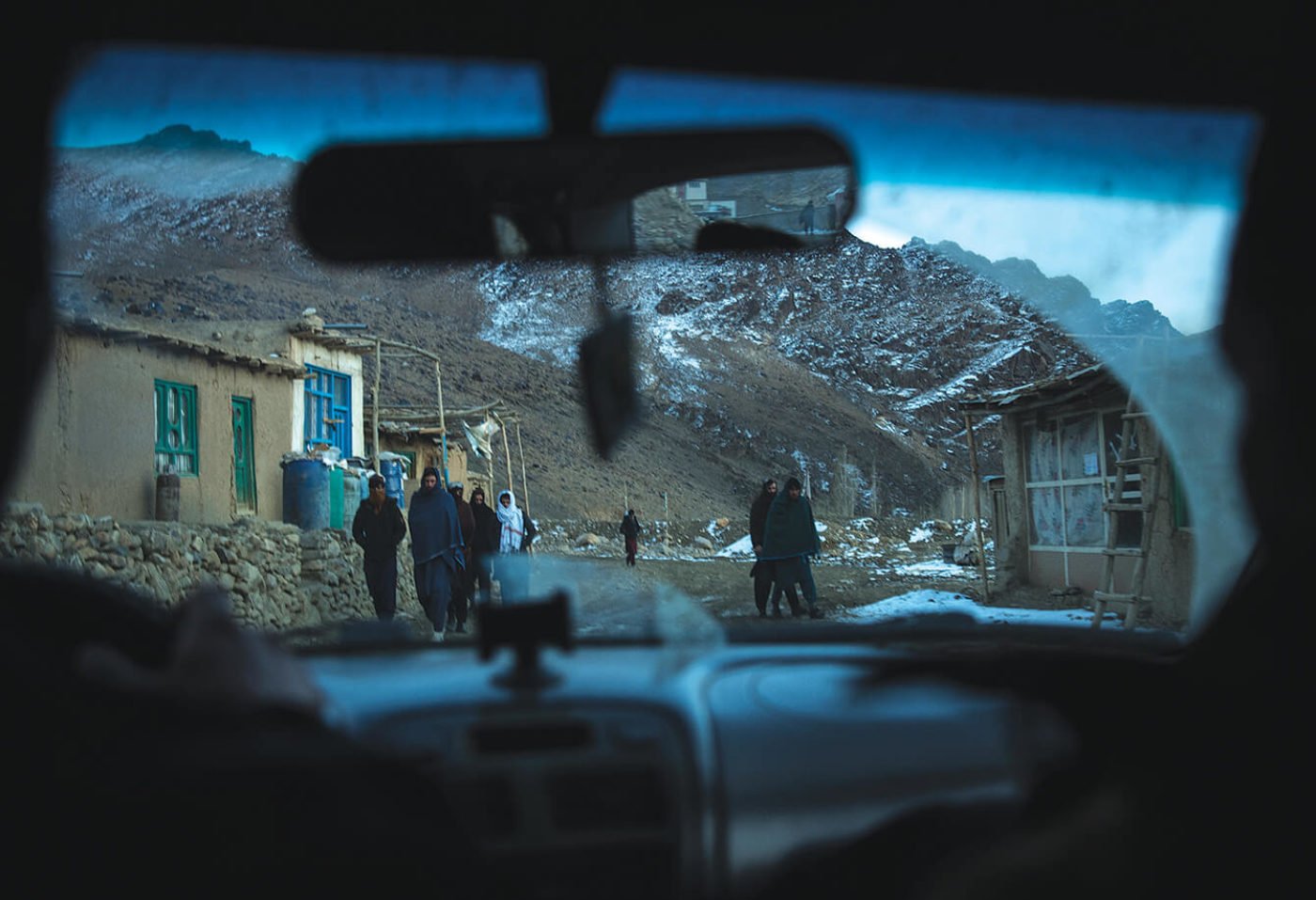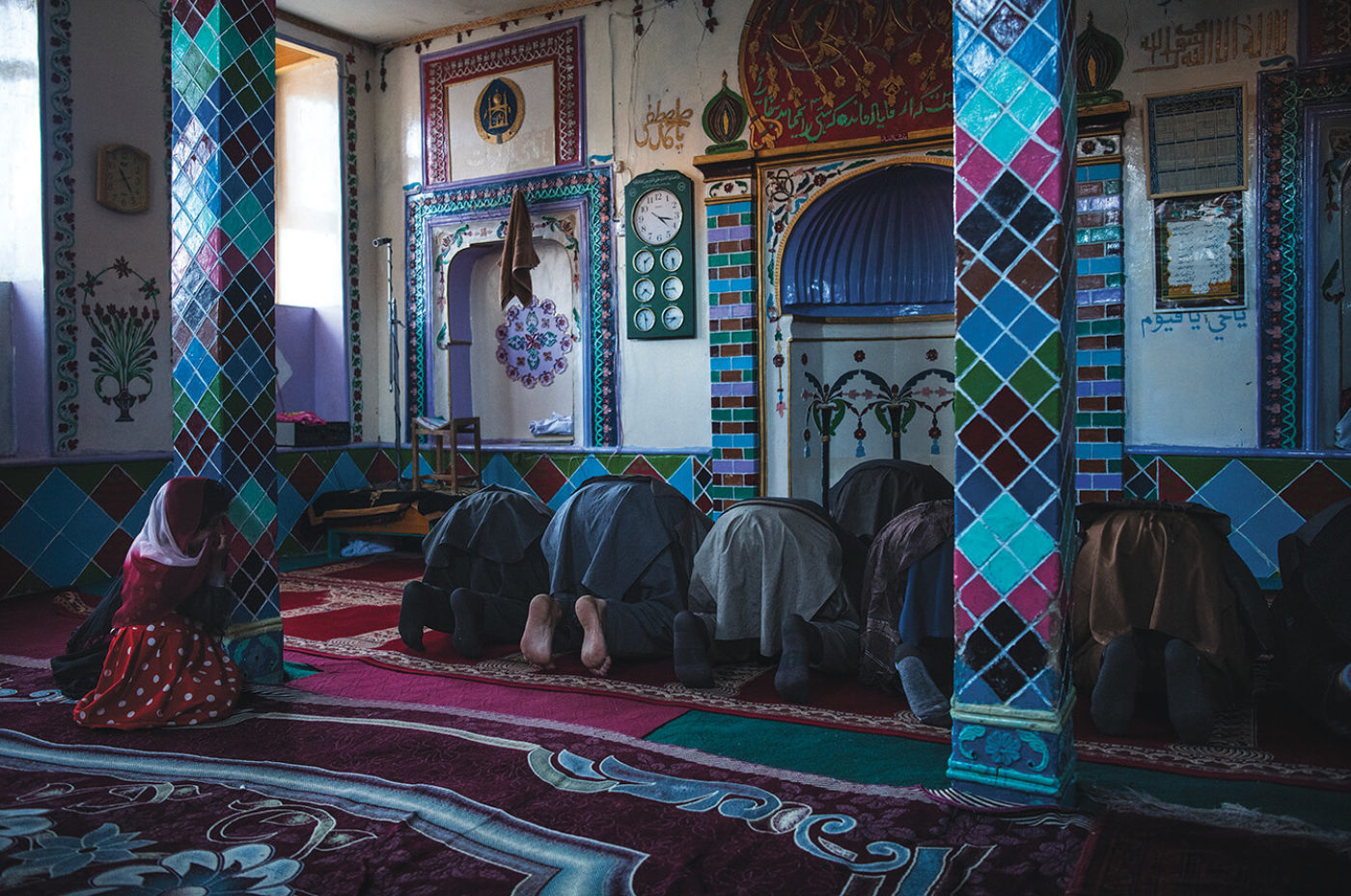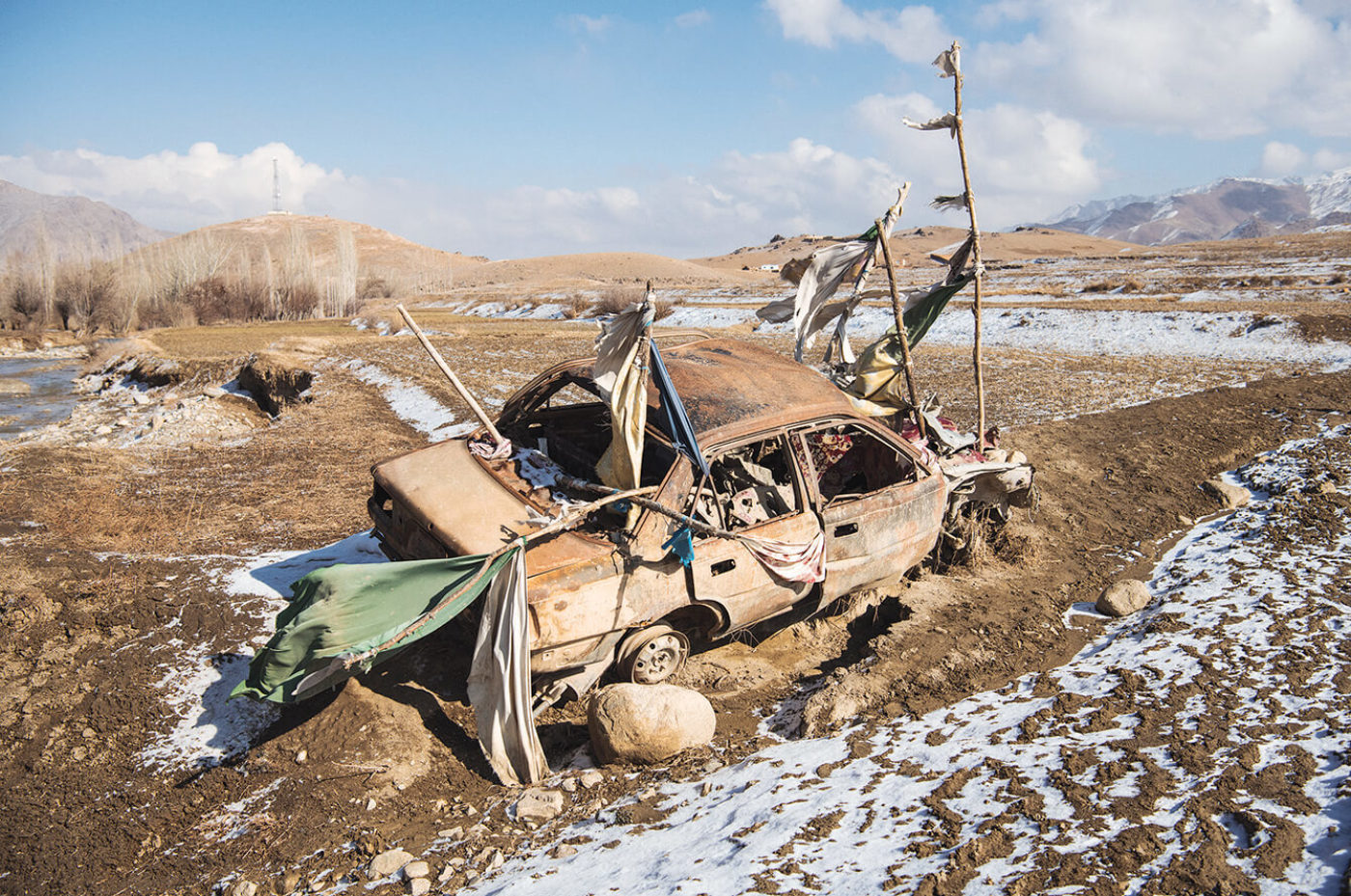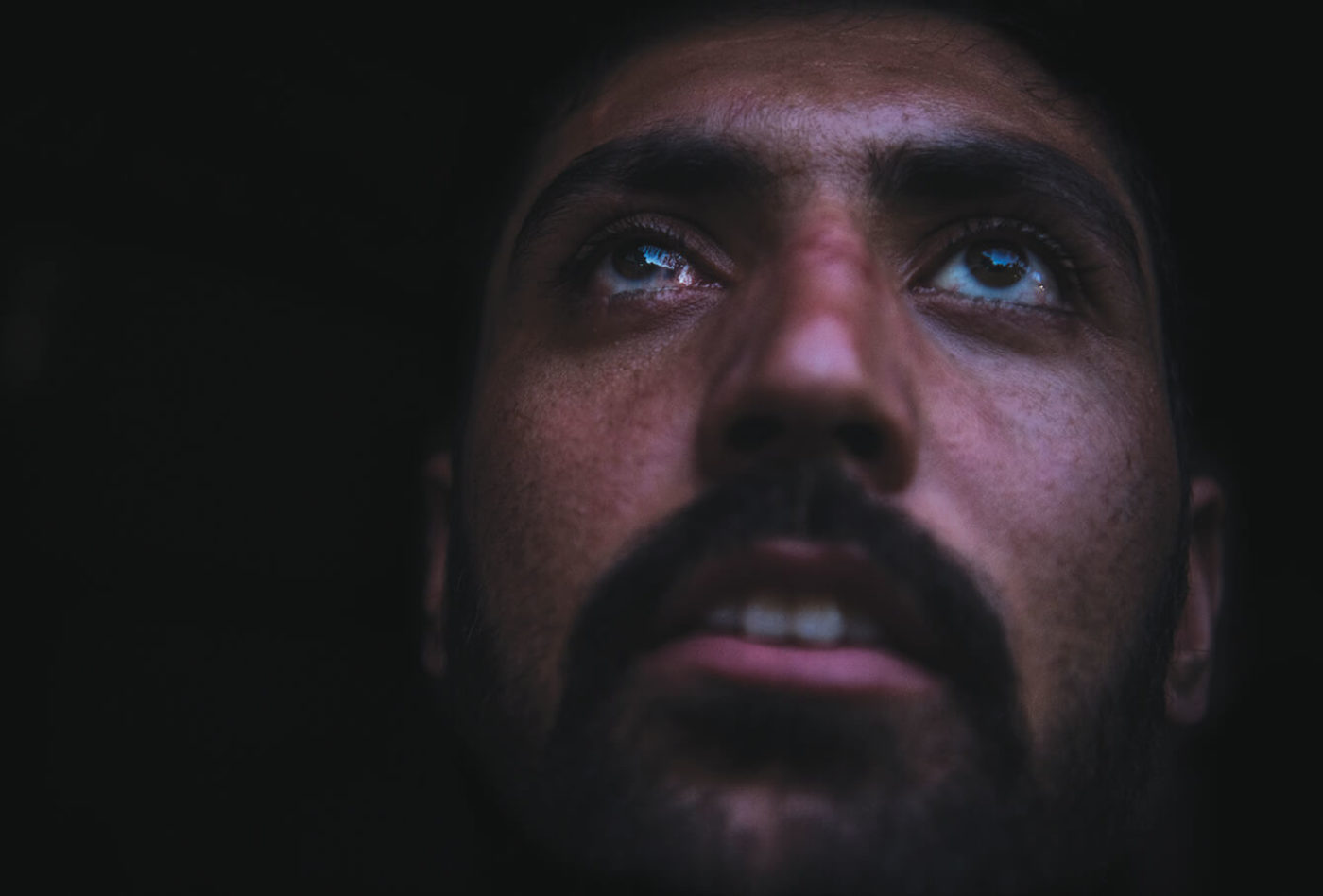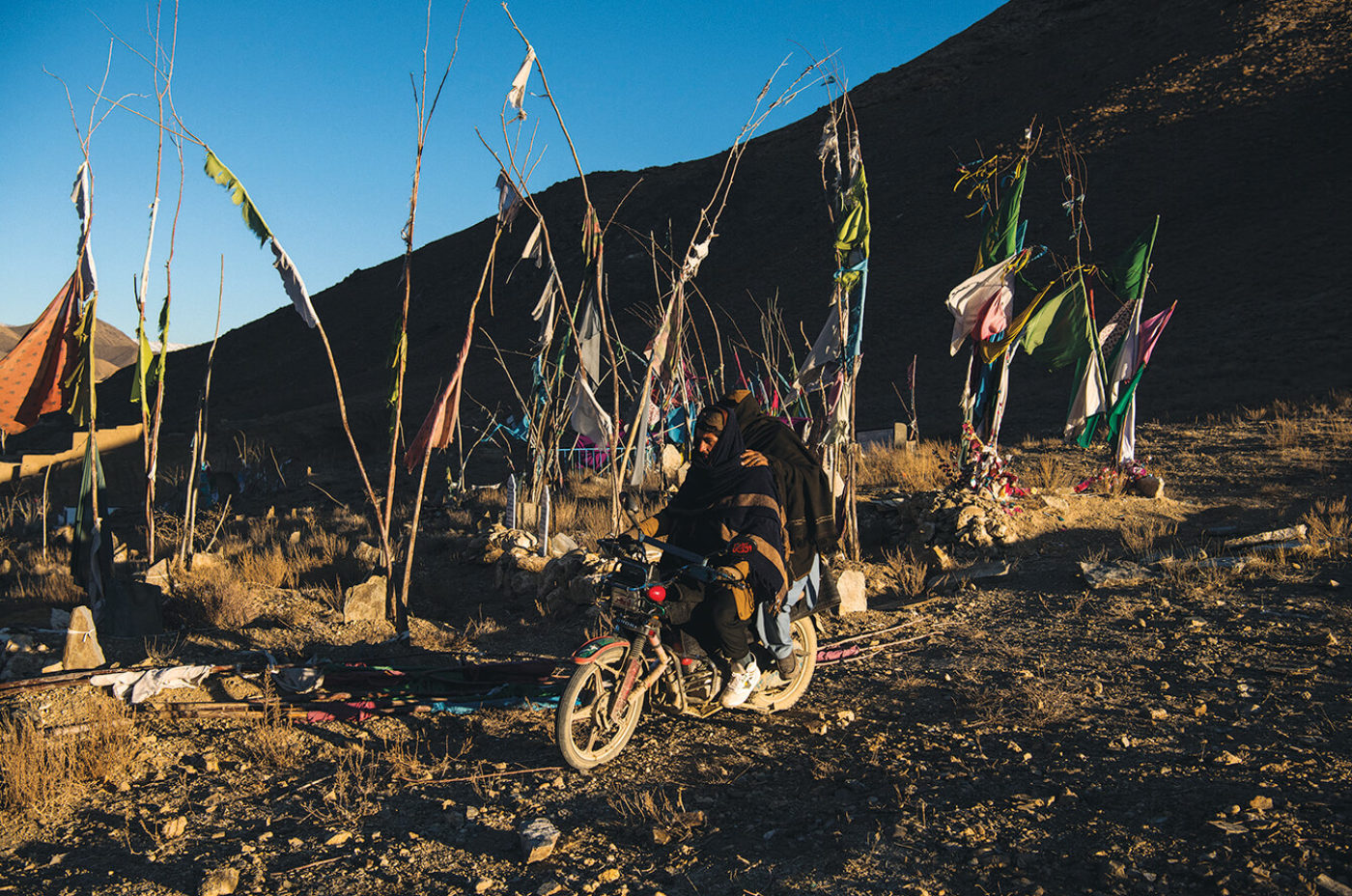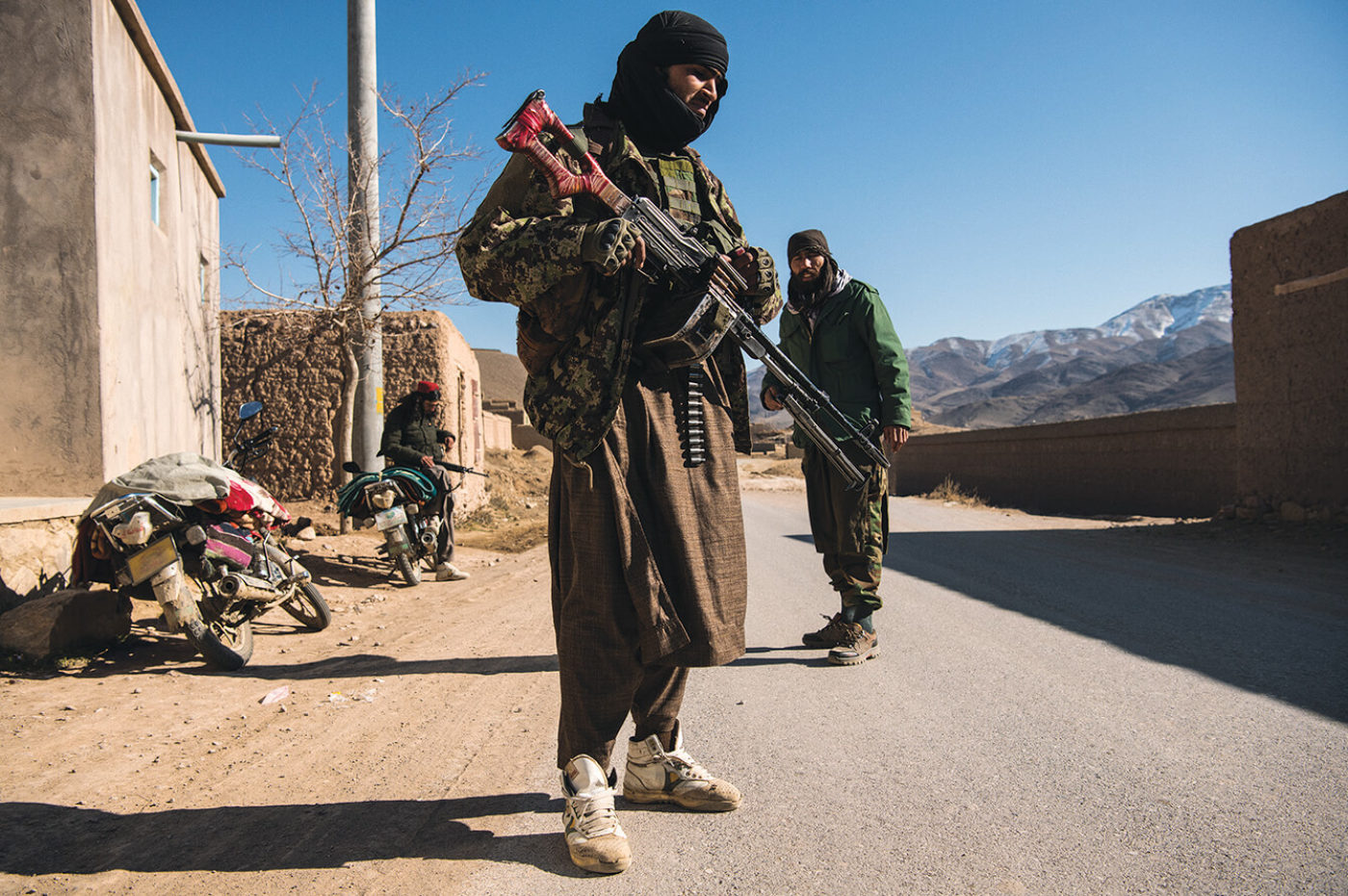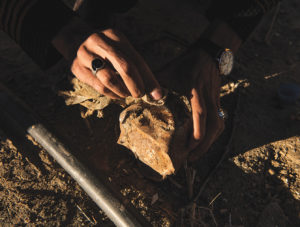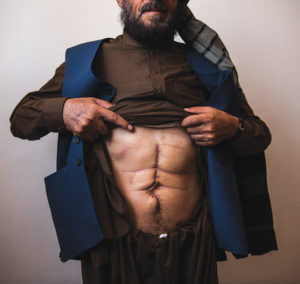When the Raids Came
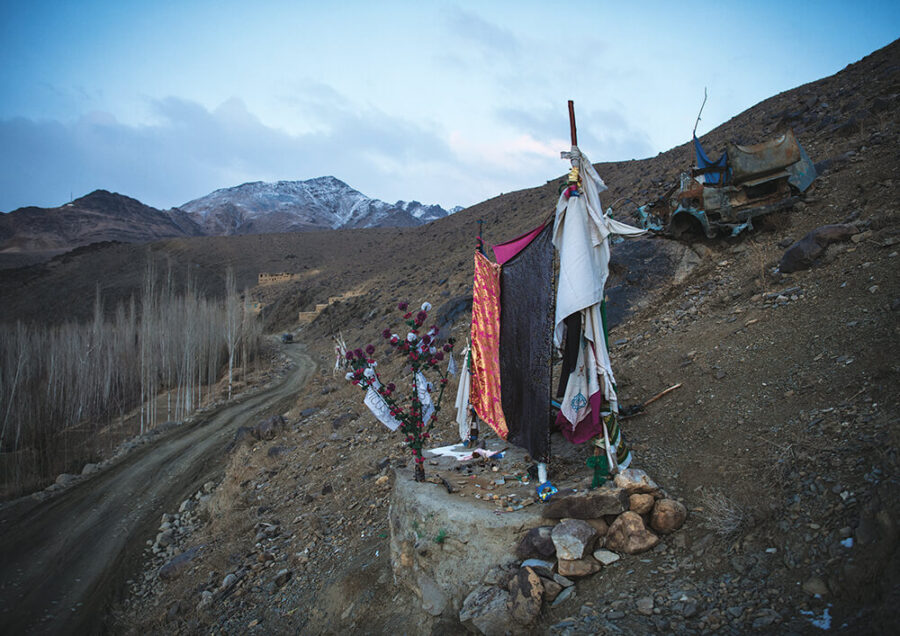
A memorial for the passengers of a car hit by a U.S. air strike in Chak district. All photographs from Wardak province, Afghanistan, by Andrew Quilty © The artist
Abdul Jalil Anees was born in the mid-Sixties in Sher Toghi, a village three hours from the nearest highway in central Afghanistan’s Wardak province. His father grew wheat, potatoes, and red apples on the same land Abdul Jalil would later farm with his own sons. It was a period of relative peace and prosperity, the product of a Cold War struggle for influence that saw the United States and the USSR plying the impoverished country with massive infrastructure projects.
In 1979, however, the Soviets invaded, installing a new leader and waging war against the Mujahedeen, a group of anticommunist guerrillas. A year later, after completing ninth grade in Wardak, Abdul Jalil followed his older brother into the Communist national military. “We had no interest in their ideology,” he says, but “they had uniforms and discipline, and, as a sixteen-year-old, I really liked that.” After seven years of training, he was deployed to the southern province of Kandahar, where he reached the rank of major.
Abdul Jalil’s indifference toward Communist doctrine turned more hostile after his family was forced to redistribute portions of its land among Sher Toghi residents. He declined a scholarship to study in the USSR and began working against the regime from within. Many soldiers were indirectly helping the Mujahedeen at the time, he says: “We used to hand weapons over to the shops and the Mujahedeen would come to collect them.”
Soon after the Soviets withdrew from Afghanistan in 1989, Abdul Jalil quit the army. After a decade, he was ready to return to the life he’d left behind. He surrendered to a Mujahedeen faction that he believes spared his life because of the weapons he provided. Back in Sher Toghi, he married Bibi Karima Ghiasi, who was also from Wardak. When his older brothers moved on, he took over the family home, caring for his elderly parents and tending their fields.
The Mujahedeen reduced the capital city of Kabul to rubble during the civil war that lasted from 1992 to 1996, but their battles barely affected those living in the remote valleys of Wardak. Nor did much change in Sher Toghi when Kabul fell to a group—whose members described themselves simply as religious students, or taliban—that had risen up in Kandahar in response to the depredations of the marauding Mujahedeen. While they may have been given formal titles such as district governor or military commander, the local mullahs “were the same people we’d grown up with,” Abdul Jalil says. When changes did come, they were mostly superficial; men had to grow their beards and music was banned, but cultural traditions that contravened Taliban edicts were generally permitted locally. “The Taliban were not as strict in the villages as they were in the big cities,” he says. Women in Sher Toghi, for example, “could go to the fields, farm, and feed their animals, and the Taliban did not cause any trouble.”
On the evening of September 11, 2001, Abdul Jalil was at home listening for news of fallout from the assassination, two days before, of Ahmad Shah Massoud, the leader of the anti-Taliban Northern Alliance. Before long, reports of planes striking buildings in New York and Washington began to flood the Voice of America broadcast.
In rural Wardak, the subsequent U.S. invasion and the crumbling of the Taliban were as unremarkable as the group’s rise. American air strikes like those that targeted Taliban leaders and Al Qaeda fighters in the country’s east and south, and celebrations with music and dancing like those that took place in Kabul, were wholly absent from Day Mirdad, the district in southern Wardak in which Sher Toghi lies. Local Taliban officials shed their titles and “went back to civilian life,” recalls Abdul Jalil. “People adapted to the change.”
The years under the Taliban had been peaceful in Wardak, but coming off the civil war and coinciding with a crippling drought, they had been a time to endure rather than thrive. “The Taliban regime was good,” says Abdul Jalil, “but the poverty levels were so high. So we were optimistic. Maybe, if the U.S. comes,” he remembers thinking, “our economy—work, job opportunities—will increase, and our lives will improve.”
Fazelminallah Qazizai, a journalist from Wardak, was a child at the time, but he remembers how Wardakis saw heavy snowfalls as signs that better times were ahead. After several years of poor harvests, optimistic farmers thought the Taliban might have been responsible for their run of bad luck. Shuhrat Nangial, the author of more than fifty books about Afghanistan, is also from Wardak. “Afghans have never approved of any foreign invaders,” he says, “but some impacts the Americans had since 2001 were welcomed.” Those effects, however, were felt primarily in the cities, where development dollars were invested in public services and security measures with which the new administration, staffed largely by senior figures from the Northern Alliance, was able to leverage support. In Wardak, the government presence was “not in a form that people respected,” Nangial says, because services were nonexistent. “The government didn’t care about the people in Wardak. They didn’t listen to their grievances.”
Qazizai sees this as the first flaw of the post-2001 order in Afghanistan. He blames the United States’ empowerment of senior anti-Taliban figures for laying the foundation for revolt. Afghan allies of the international forces cynically identified rivals as members of the Taliban or Al Qaeda. Those denounced were either killed or detained, and treated cruelly while being mined for intelligence they often didn’t possess. Qazizai cites stories that began to filter back to the families of detainees in Bagram and Guantánamo Bay—and even of unrelated detainees in Abu Ghraib, Iraq—“that fueled people, especially in Wardak, to take up weapons against the U.S.”
Abdul Jalil’s first encounter with the Americans didn’t come until a year or two after their arrival, when a few armored vehicles rolled through Day Mirdad in a convoy with Afghan forces. “They never spoke to us face-to-face,” he says. “We’d just see them passing on the road.” The snaking convoys coming from Kabul would often stop on their way to the district center, but they never stayed for long. “At first, we thought how strange they looked,” says Abdul Jalil’s second eldest, Nasratullah. “We’d never seen such people before.” He recalls Wardakis’ attitude toward the Americans as curious, but wary: “When the convoys saw people on the road they’d stop and provide cakes and sweets.”
Wardak’s proximity to the capital, Kabul, was also beginning to underscore the growing urban-rural divide in Afghanistan. While the livelihoods of Wardakis who prospected for opportunities in Kabul often improved, those who stayed behind saw little change.
Abdul Jalil first sensed what was fomenting in Day Mirdad when two members of a council of elders on which he served received letters from the Taliban warning them to stop collaborating with the government. “Slowly, slowly, insecurity grew,” he says.
As the U.S. military shifted its focus to Iraq in the mid-Aughts, animosity toward the outsiders began to coalesce into coordinated revolt. Former Taliban fighters recovered weapons they’d abandoned in 2001 and reorganized into small units. Because the Americans had little permanent presence in rural Wardak, early insurgents adopted hit-and-run tactics against convoys on the Kabul–Kandahar highway. Meanwhile, more senior members began recruiting and establishing shadow administrations in various districts.
As the American footprint in Wardak increased—first in 2009, when as many as two thousand American soldiers were deployed to the province, and again in 2010, following Obama’s troop surge—so did the Taliban’s ability to recruit new and increasingly aggrieved fighters. By 2011, violence was surging. Taliban fighters downed a U.S. Chinook helicopter in Wardak, killing thirty Americans and eight Afghans in the deadliest incident for American forces in the entire war. The following month, fighters detonated a truck bomb outside a combat outpost, injuring seventy-seven coalition troops. U.S. forces countered with large-scale clearance operations, as well as night raids and air and artillery strikes. After a Green Beret team was accused of human-rights abuses in 2013, antipathy toward the Americans became so acute that then-president Hamid Karzai ordered all U.S. Special Forces out of the province.
“At first, there was no support for the Taliban,” says Mullah Omari, a Taliban military commander who currently serves in Day Mirdad. “It was when the Americans started killing civilians that people started supporting us, giving us food, bullets, and offering men.”
All the while, Abdul Jalil and Bibi Karima were raising their family. By 2014, they had eight children: four boys and four girls.
The eldest two, Fawad and Nasratullah, who are now twenty-three and twenty-one, were close but combative. “Most of the time we were fighting,” Nasratullah says, laughing. “Just over little things: a ball, a bicycle. Whenever our father would bring something home, we’d fight over it.”
They both attended Babak High School, to which they’d walk or ride bicycles. Fawad was a diligent student. Nasratullah wasn’t: “Most of the time, I was just looking for ways to leave. Sometimes I’d leave early and wait for the others to finish before going home. The family shouldn’t know that I was escaping from school.” His father was aware that Nasratullah had little interest in his studies, but he denies that his son was spending more time outside the classroom than in. “I used to go to the school to speak with the principal and teachers to make sure he was attending,” Abdul Jalil says. “My family were all well educated. We were very strict about education.”
Accessible only by a bumpy dirt road, Day Mirdad was of little strategic importance and was virtually ceded to the Taliban by 2010. With government forces confining themselves to their compounds, Taliban fighters roamed freely. Abdul Jalil was concerned about Nasratullah, who was listless and impressionable. He had good reason to be worried. Nasratullah was in the fourth grade when he first saw Taliban fighters in Sher Toghi. “I was sitting in the mosque,” he says, “and we asked the mullah what they were doing. He told us they were doing jihad . . . and the stories left a big impression on me.”
Fawad graduated from high school in 2017 and moved to Kabul to study at a private medical university. Nasratullah finished the following year. By then, his friends had begun to join the Taliban. Reluctantly, at his father’s urging, he started preparing for the university entrance exam while farming and helping contractors expand the home the family had purchased four years earlier.
Not satisfied that he was doing enough to keep his second son occupied, Abdul Jalil says, he sent him away to Iran. Nasratullah casts the decision to go as his own, one made “for pleasure,” though he was encouraged by his family and friends. “We also thought we should work while we were there,” he says, referring to the two friends he traveled with, “because there was no work here.” Like hundreds of thousands of unemployed Afghan men each year, they traveled without passports or visas through the desert in southwestern Afghanistan before crossing into Pakistan, and then Iran.
The economic boom in Afghanistan that had been fueled by foreign development aid foundered after international combat operations formally ended in 2014. Unemployment soared almost immediately, helping to drive a mass exodus of young Afghans to Europe. In a 2019 Asia Foundation survey, only 36 percent of eighteen- to twenty-five-year-old Afghans reported earning an income. The paucity of job opportunities was a major source of dissatisfaction with the Afghan government, positions in which are earned more often through nepotism than merit. Although no figures exist on the number of Afghans crossing illegally into Iran in search of work, the International Organization for Migration counted more than 760,000 Afghans returning from Iran—voluntarily or otherwise—in 2018.
Nangial says the Taliban capitalized on the population’s resentment toward the government and its urban constituents, as well as on grievances over U.S. and Afghan military abuses. “It’s not a war of belief in Afghanistan,” he says. “The people had expectations: better lifestyle, better living standards.” The government squandered its opportunity. “Nobody wants a Taliban government there,” but faced with a choice between neglect and contempt from the government in Kabul, and the nominal respect they’re shown by Taliban fighters who live ascetically among them, most will reluctantly accept the locals. For his part, Abdul Jalil is loath to endorse anyone. “Honestly, we’re stuck in the middle . . . We’re not really happy with either side.”
In September 2018, as part of his strategy to fight the then-seventeen-year-old war using “all instruments of American power—diplomatic, economic, and military,” Trump appointed the Afghan-born U.S. diplomat Zalmay Khalilzad as special representative for Afghanistan reconciliation. The first of several rounds of peace talks between Khalilzad and representatives of the Taliban commenced the next month in Doha, Qatar.
By then, the military component in Trump’s strategy was already under way. In 2017, the Pentagon had relaxed its rules of engagement and escalated its air war. The following year, with some fourteen thousand troops in Afghanistan, the United States dropped more munitions from its aircraft than it had in 2010, when troops numbered one hundred thousand. “The entire purpose behind our air campaign,” a U.S. Air Force general explained in June 2018, “is to pressure the Taliban into reconciliation and help them realize that peace talks are their best option.”
In Wardak, the increase in violence wasn’t confined to air strikes. Stories of brutal night raids, carried out mostly by a CIA-trained and funded unit known as 01, with the support of American Special Operations Forces, CIA paramilitary officers, and U.S. air power, had been spreading through the province since late 2018. The victims were rarely insurgents, but rather civilian families living in areas under Taliban control, or students of madrassas as young as eight. Wardak residents and government officials interviewed in 2019 described 01’s raids—arguably the most deliberately ruthless since the war began—as a campaign of terror that claimed dozens of civilian lives. Patricia Gossman, an associate director for the Asia division of Human Rights Watch who documented the raids in a 2019 report, says that the Taliban is known to recruit from madrassas, and so their students may have been targeted because they were seen as potential future enemies. According to Nangial, the same guilt by association can attract raids against residents who have complied with requests by Taliban fighters for food or lodging.
Saturday, February 23, 2019, dawned bright and blue in Sher Toghi after three days of snow that had ensured respite from the raids. Three weeks earlier, Fawad had returned for winter vacation from Kabul, where he was studying oral medicine. He spent the morning with friends in the village square and at the local mosque, a social hub during winter because it was kept warm day and night. When he returned home in the afternoon, he was greeted by a friend asking after Nasratullah, who was still working in Iran. The two drove to a grocery store and drank tea until they heard the muezzin’s call to the evening prayer.
It was dark by the time Fawad got home. His mother, five brothers and sisters, and a fifteen-year-old boy named Wahidullah who worked at the house were waiting for him and his father, who was attending a meeting with local elders, so they could eat dinner.
By 9 pm, the whole family was asleep on long, flat cushions or folded blankets around the living room, warmed by a traditional wood-burning heating system. Wahidullah slept on his own in the kitchen.
Fawad slept beneath a large window that framed a view over the single dirt road that runs through Day Mirdad and across the valley floor, where bare poplars and apple trees sprang from the snow.
It was Bibi Karima who woke first. “Get up! It’s a night raid!” she shouted.
When Fawad came to, he heard helicopters. Out the window he could see two double-rotor Chinooks landing in a field across from the house. Human figures, silhouetted against the snow, spilled from their loading ramps. Fawad looked at his phone. It was 10 pm.
He told his father, the only other grown man in the house, to put on warm clothes. “Be ready,” he said. “Maybe they will search the house. If they do, they’ll take us outside, and it’s freezing.” In response, Abdul Jalil told Fawad to find his university ID and to keep it on him. “My brothers and sisters were screaming and crying,” Fawad says, “but I told them, ‘It’s a raid, yes, but it’s not on our house.’ ”
Minutes passed, and the soldiers who had moved west through the field disappeared from view. The Chinooks lifted off and vanished into the night. The mood in the house eased even as intermittent gunfire and explosions continued near the center of the village. There, in another field adjacent to a small mosque where a group of around fifteen Taliban fighters was staying, two Chinooks were depositing more soldiers. One of Abdul Jalil’s nephews, Mohammad Omar, lived nearby. “Our clothes were drying outside and the helicopters blew them all off. That’s how low they were flying,” he says. His eight-year-old daughter clung to him, and implored him to hold her tighter so her heart wouldn’t stop.
Occasionally, Fawad would peel back the blanket that insulated the window to try to glimpse what was happening. Although he rarely saw them, Fawad could hear jets, helicopters, and a lumbering AC-130, the most feared of all close-air-support aircraft in the American arsenal. Fawad joked with his fifteen-year-old brother Enayatullah that once the helicopters left he should go to the village, and “maybe you’ll find some shoes or equipment and things.” Even when the firefight died down, the roar of jets wavered through the valley. Around 3 am, Fawad recalls, “We were just up talking.” Outside, the landscape was lit up by flares that trailed smoke as they fell slowly to the ground.
Then, Fawad says, he saw “a bright light. Then, bang!”
A bomb hit an empty room on the other side of the house. The windows exploded. Fawad clutched at his right eye. “When I touched it,” he says, “I thought it might have come out.” It was dark inside: “We weren’t able to see each other—who got injured and how,” but Abdul Jalil managed to usher everyone toward the kitchen. Through the windows they saw dark figures and then muzzle flashes: soldiers opening fire from the perimeter wall. As they huddled on the floor with rounds bursting through the windows, another explosion, bigger than the first, shook the house.
Abdul Jalil, his face bleeding, hurried his wife and children and Wahidullah into a small bathroom with a single window. Abdul Jalil spread a blanket over the family for warmth. Fawad sat on a water tank and raised his head to peer outside. The family yelled at him to get down. A moment later, bullets struck the window and the wall behind him.
Then another explosion engulfed them. “My ears were ringing,” Fawad says, “but I could still hear the screams and the cries of my family.” He was unable to move, pinned beneath a crushing weight. Maybe I’m dead, he thought. “I took a deep breath and tasted dust.” With his one good eye, Fawad looked around. Splintered beams and broken slabs of mud had collapsed around him. “Then,” he says, “I looked up and saw the sky.”
Fawad pulled himself out of the rubble and freed Enayatullah so the two of them could work together to rescue the others. They pulled fourteen-year-old Zeinab out next. One of her legs was badly broken and burnt, as was her face. Next Fawad dragged his father free. His mother and sisters, eight-year-old Zeenat and six-year-old Fatima, were crying for help; they were alive. Abdul Jalil collapsed and appeared to be unconscious. “I started crying,” says Fawad, “but went back to working on the others.” Enayatullah told Fawad that he was going to find help. “Don’t go outside,” said Fawad. “Help me here, to rescue the others.” He continued trying to pull debris away from where his mother and sisters were trapped. When he turned to check on Enayatullah, his brother was nowhere to be seen. “Suddenly, a helicopter crossed above us and fired,” says Fawad. “They’d shot my brother. There was nothing I could do.”
His mother and two youngest sisters were still stuck. As Fawad tried to clear dirt from around his mother’s mouth so that she could breathe, soldiers appeared behind him, yelling in Pashto and Dari. As Fawad turned, he was shot in the knee, but barely recognized the pain at first. “I raised my hands and said the Kalima,” says Fawad. “I thought they were going to kill me.” One of the soldiers searched his pockets. “After they took out my university ID card, he said to the others, ‘Don’t kill him. Search the house.’ ” Fawad pleaded with the soldiers: “Please, forget searching the house. Look, my father is injured, and my two sisters and mother are under the fallen roof, they’re going to die.” Then they bound his hands.
The soldiers picked up his ten-year-old brother, Rafiullah, who had suffered only minor injuries but was distraught, and dropped him on top of Fawad, who was told to calm him down. Two soldiers crouched beside Abdul Jalil and began tending to his injuries. They were foreigners—Americans, suspected Fawad, Abdul Jalil, and Rafiullah. One bandaged Fawad’s head and knee. “The foreign soldiers were helping us,” says Rafiullah. “One foreign soldier touched my brother’s eye and shook his head in pity. The Afghan soldiers were shouting at us and walking on top of where my mom and sisters were stuck.” Another foreign soldier, a woman, was filming or taking photographs. At one point, Fawad says, she sat beside him and asked one of the other foreigners to take a photo of the two of them. Abdul Jalil, who had suffered broken ribs and shrapnel wounds, was drifting in and out of consciousness, but recalls hearing Fawad asking the soldiers to help his mother and sisters. “They could have, but they didn’t,” he says. “Until that moment, my two daughters, along with their mother, were alive and stuck in that small bathroom.”
Abdul Jalil, Fawad, Zeinab, and Rafiullah were strapped to stretchers and carried out of the house, across the road, and into the field where the Chinooks had landed earlier. By the time more helicopters arrived, Fawad was so cold he couldn’t feel his legs. After around thirty minutes in the air, the four patients were transferred to waiting ambulances. It wasn’t until Fawad heard the driver mention Macroyan, a neighborhood in Kabul, that he knew where they were. They were driven to a large hospital in the center of the capital run by the National Directorate of Security (NDS), Afghanistan’s intelligence agency, where they received preliminary treatment. Fawad could hear his father and Rafiullah nearby, and asked a nurse about Zeinab. When the nurse brought her to his bedside in a wheelchair, Fawad, whose face was swollen and speckled with shrapnel wounds, says, “She began to cry. She didn’t recognize me because of my injuries.”
After two nights in the hospital, with Abdul Jalil in critical condition, the four patients were given new clothes and transferred again to an ambulance. The driver dropped them a few miles away by the entrance to the Intercontinental Hotel, bought them juice, and paid for another taxi to take them farther, offering Fawad the use of his phone before he departed. Fawad knew the number for his uncle, Gulam Jirani Bariulai, by heart.
It was the first time anyone from the extended family had heard from them in days. Bariulai, a doctor who lives in Kabul, had received a call hours after the attack from his brother, Mohammad Omar, who was in Sher Toghi, and had driven there immediately. Cars lined both sides of the narrow road below the house, where an excavator was lifting away the rubble. The bodies of Bibi Karima, Zeenat, and Fatima had already been found and removed from the wreckage. Wahidullah, the young worker, was also dead. Enayatullah, who had run to get help, had been found first, on the road, one hundred yards from the house. His body had been torn apart by high-caliber rounds, likely from an attack helicopter. One arm had been completely severed. By this point, no one from the village knew whether Abdul Jalil and the missing children were alive or dead. Their phones were all switched off. Mohammad Omar, Abdul Jalil’s cousin, had found his glasses in the ruined house. Graves were dug for the eight family members and for Wahidullah. Around midday, word spread about a call that had been received, possibly from the NDS hospital. The four missing family members were alive.
Bariulai met the taxi in western Kabul. Aside from Rafiullah, he says, “Fawad was the only one who could walk.” Bariulai took Zeinab to a hospital that specialized in burns and Abdul Jalil to another hospital for scans and X-rays. Doctors there told Bariulai that Abdul Jalil would need to be taken to Pakistan for treatment. In an ambulance, Mohammad Omar and Bariulai nursed Fawad and Abdul Jalil, who was on oxygen, for five hours, until they reached the border, where they had arranged for another ambulance to meet them. A doctor at the hospital had warned Bariulai: “If you stop oxygen for five minutes, he’ll die.”
Abdul Jalil underwent surgery in Peshawar to repair a ruptured liver and other internal wounds. He returned to Kabul in May, three months after the attack. I spoke to him there soon after at the home of a relative. “We’re taking shelter here for now,” he told me. “There are still air strikes, so we will wait until it stops. Plus, our house is destroyed.”
Nasratullah had been working for an engineering company laying a road in Esfahan for about a month when he received a message from a friend telling him there had been a night raid, and that one of his brothers had been killed. He called around and, after three days, believed that only his father and brother had been injured and were recovering in the hospital. Still, he was unable to reach anyone from his immediate family. “We didn’t want to tell him what had happened,” Fawad says. “We just wanted to tell him to come home.”
Without enough money to pay for a flight to Kabul, Nasratullah waited more than two weeks to receive his salary, which still didn’t amount to enough for airfare. Knowing that undocumented Afghans were deported when the police caught them, he decided to turn himself in. He was taken to the border, near the city of Mashhad, and, with hundreds of other Afghan workers, walked into the Afghan province of Herat, where he boarded a bus to Kabul.
Nasratullah had spoken to friends and family about the raid but didn’t know whose account to believe. He needed to see for himself. “When I reached the village and saw the house,” he says, “I thought it was a dream. Everything was destroyed. There were no doors, no windows . . . I couldn’t control myself. I couldn’t even cry. . . . The only thing to do was to pray for those who were killed and for those who were injured.”
In the year after the February attack, 01 conducted dozens of similar night raids, striking homes occupied by families, mosques where a traveling salesman and a man with a severe mental disability slept, and madrassa dormitories full of young students who came from outlying areas of Wardak. I wrote about the campaign for The Intercept, documenting ten raids that resulted in fifty-one civilian deaths. No U.S. agency or department responded to detailed questions about them.
On February 29, 2020, Khalilzad, the special envoy, pressured by Trump’s political timeline, signed an agreement with the Taliban that some hoped would pave a way out of the war. The agreement was accompanied by an immediate ceasefire between the United States and the Taliban. The night raids, which had slowed toward the end of 2019, stopped almost entirely, although it was unclear to what extent the CIA was de-escalating in order to adhere to the deal.
That May, an Afghan journalist with whom I had been working, and who has asked to remain anonymous for fear of reprisal, met with a close mutual friend of a young but notorious Taliban commander named Mullah Qasim—Day Mirdad’s shadow governor at the time. The friend spoke about how life in Wardak had become peaceful after the signing of the Doha Agreement. Fawad, who was in Sher Toghi while his university was closed because of COVID-19, said at the time, “There’s no bombardments or night raids. People are happy; it’s like Eid. The Taliban are more relaxed, too.” The friend also told the journalist about a new recruit of Mullah Qasim. The recruit’s family, he said, had been targeted in one of the previous year’s night raids. His name was Nasratullah.
A month later, in June 2020, I met Fawad for tea by a lake on the edge of Kabul. A year after we’d first met, his eye was mostly healed and he now wore a short beard. He spoke about his family and of the relief people in Wardak had begun to feel since the night raids ceased. Under Taliban control, with no front line within fifty miles of Sher Toghi, life had returned to normal. When asked about young men joining the Taliban in response to the previous year’s spate of night raids, Fawad initially deflected, agreeing that recruitment had jumped in general, without acknowledging his own experience. Eventually, he relented. “Mullah Qasim was the district [shadow] governor at the time,” he said. “Nasratullah went directly to him.” Furthermore, Fawad confessed, he, too, had considered the path his brother had chosen. “I had the same decision to make as my brother,” he said. “When I see the government and NDS, I hate them.” Ultimately, Fawad decided against it. “One in my family is enough,” he said. “I can continue my studies and support the family.”
At the end of 2020, after five months of negotiating with Taliban representatives, I was granted permission to travel to Sher Toghi to meet Nasratullah alongside an Afghan journalist (who out of concern for his safety asked to remain anonymous).
Snow lined the highway as our taxi drove south from Kabul. Fawad came with us. Every couple of miles between Maidan Shar and the turnoff to Day Mirdad, the traffic slowed to swerve around craters left by Taliban mines. Once we were off the highway, beyond a handful of small mountaintop outposts of the Afghan National Army, it was often difficult to discern who was in control. The Taliban, whose fighters are mostly locals, doesn’t rely on the kind of infrastructure that government forces do. An occasional Taliban flag—white and emblazoned with the shahada—flapping above a mud-walled compound, or a cluster of fighters on motorcycles, their Kalashnikovs barely concealed by shawls (or displayed openly at temporary checkpoints), were all that indicated that the insurgents held sway.
We traversed Gaw Kush, a remote mountain pass where Nasratullah and village elders had driven to welcome Fawad and their father when they returned after the attack. During the approach to Sher Toghi, we passed macabre memorials to civilians and fighters killed during the same 2019 campaign: twisted remains of vehicles destroyed by air strikes, often marked by tall timber poles adorned with strips of colored fabric.
We were greeted by Mullah Omari, a thirty-five-year-old Wardaki whose black, shoulder-length hair and beard disappeared seamlessly beneath the loops of his silk turban. Omari, who was traveling with a bodyguard, was Nasratullah’s new commander. We followed Omari’s black Toyota station wagon to a small mosque, whose brightly painted interior was in stark contrast to the drab, earthen exteriors of rural Wardak’s homes.
Nasratullah was easily recognizable as Fawad’s brother, but he was brusque and aloof in comparison. His clothes—high-hemmed pants and white high-tops—also distinguished him as a fighter.
“When those who were injured returned from Pakistan, that was when I took up a gun,” says Nasratullah. “But I had this idea from a young age.” Before the attack and before he left for Iran, he says, “I didn’t have a beard and wasn’t able to actively work for the Taliban.” He does, however, say he used to help local fighters by collecting food and ammunition. Though they acknowledge Nasratullah’s long-held fascination with the Taliban, his relatives believe the attack was a greater motive for his enlistment than he lets on. His cousin Mohammad Omar, who was in Sher Toghi the night of the attack, says that Nasratullah was manipulated by the Taliban. When he arrived home from Iran, Mohammad Omar says, “a group of Taliban came to him and said, ‘Your family has been martyred by infidels,’ and gave him an AK-47 . . . and encouraged him to join them to take revenge.”
After joining, Nasratullah spent two weeks doing basic training in a Soviet-era fort in the hills behind Sher Toghi. Since then, he says, he has participated in operations in the neighboring Chak district and Ghazni province, south of Wardak. During Ramadan, this May, he also took part in an aborted offensive to seize Day Mirdad’s district center.
Before the sun disappeared behind the mountains on the opposite side of the valley, at the foot of which the four family members are buried, Fawad offered to take me to their home. The northern half of the house, which had been leveled in the attack, was being rebuilt as it had originally stood. Fawad walked me through the bare reconstruction, from the window beneath which he’d slept and through which he’d seen the Chinooks in the snow, to the kitchen where they had run for cover after the first air strike, and to the bathroom where they were sheltering when the final munition struck.
In a storage area beneath the house, Fawad unfurled a sack of irregular chunks of steel. Some of them were dull and rusted, while others had retained their shine. They were bomb fragments, picked from the ruins of the house. Manufacturer’s codes and markings were still visible on several pieces. One read eaglepicher, the name of an American battery manufacturer. Brian Castner, a former U.S. Air Force explosive ordnance disposal officer who now works for Amnesty International, told me while I was reporting for The Intercept that the weapon was almost certainly a GPS-guided JDAM dropped by U.S. forces.
In response to questions about the raid and the deaths of Abdul Jalil’s family members, a spokesperson for coalition forces in Afghanistan wrote, “According to our detailed records, a US airstrike took place on 23 Feb 2019. The strike targeted enemy fighters but subsequently damaged a neighboring home, injuring four children. They were medically evacuated and treated at a nearby hospital for non-life-threatening injuries. No other casualties were reported.” (The CIA and the Afghan government did not offer any comment.)
When Abdul Jalil first saw Nasratullah after the attack, he remembers finally letting go of his attempts to restrain his son. “Look what the government and the Americans have done to us,” Nasratullah told his father at the ruined house. “And he was right,” says Abdul Jalil. “As the elder of the family, they could have arrested me, detained me, and conducted an investigation if they had any reports. What was the sin of those young children and the woman they killed?”
Rahmatullah Nabil, a fifty-three-year-old Wardaki and former head of the NDS, is contrite about the mistakes that led to the anti-American, antigovernment insurrection across Afghanistan. He hasn’t visited his childhood home in southern Wardak since 2005. According to photos captured by an Afghan Air Force pilot who is friends with Nabil, the house was destroyed in the fighting. For the spate of civilian deaths in Wardak in 2019, he blames the government’s shrinking footprint in the province and the reliance on signals intelligence over human intelligence. As a result, Nabil says, even he lost relatives who supported the government to the 2019 campaign.
But poor intelligence gathering accounts for few of the atrocities. The morning after the attack on Abdul Jalil and Bibi Karima’s family, it wasn’t only in their home that Sher Toghi residents discovered bodies of civilians left by 01. Khan Mohammad, a local mullah who had once been arrested by the Taliban for providing superstitious tawiz, or talismans, to worshippers—a practice seen by the Taliban as heretical—was killed in an apparent execution, his house destroyed by explosives. A local teacher, Abdul Ghafar, was also executed. His body was found in his own tandoor oven. A taxi driver, Awlia Khan, was also killed in Doorani, one village west. “All these killings were executions,” says Mohammad Shoaib, the brother of Bibi Karima, who saw the victims’ bodies.
Nabil agrees that along with ideological and cultural forces, the new generation of Taliban fighters in Wardak is the product of two main factors: first, the American empowerment of ethnic and tribal adversaries; and second, the appetite for avenging the deaths of noncombatant Wardakis and the abuse of detainees at the hands of American and Afghan forces over two decades of war. Now, as the U.S. military departs, the Taliban is more emboldened and more likely to secure power than at any other time since 2001. After President Biden’s April announcement that the U.S. withdrawal would begin on May 1, the Taliban intensified its offensives countrywide. Though it has refrained from attacking departing American troops or Kabul, the Taliban has all but surrounded several major cities, and more than a hundred of the country’s roughly four hundred district centers, including five in Wardak, have fallen.
Abdul Jalil battled for twenty years to prevent his children from succumbing to the pull of the insurgency. “I never asked them to work in the fields with me,” says Abdul Jalil. “I wanted them to prioritize their studies.” But Nasratullah was vulnerable to the same fate that befell many of his classmates. “Most Taliban now are university graduates,” Abdul Jalil says. “But because of a lack of jobs, they join the Taliban.” Now Abdul Jalil no longer believed his own arguments. “Before the night raid, he had friends in the Taliban, but we kept him away from them and I used to tell him not to join,” he says of Nasratullah. “But after the night raid, to be honest, we didn’t have any reason to stop him. He had a better reason to join the Taliban than we did to stop him.”

